The Night Bazaar in Chiang Mai is probably the most famous shoppertunity in Thailand, although the open air market is actually open for business both day and night in the downtown area. The sidewalk is lined in both directions with tiny stalls selling cheap Thai souvenirs and counterfeit designer goods.
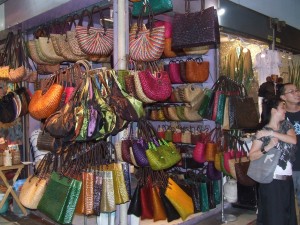 Bypass these for the real finds. Inside the main market square, vendors have tables set up in a grid offering everything from local foods to cotton clothing to handicrafts. According to everyone I spoke to in Bangkok and Chiang Mai, this is the BEST place to shop for locally-produced items.
Bypass these for the real finds. Inside the main market square, vendors have tables set up in a grid offering everything from local foods to cotton clothing to handicrafts. According to everyone I spoke to in Bangkok and Chiang Mai, this is the BEST place to shop for locally-produced items.
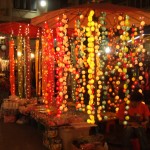 You can outfit yourself in a new wardrobe with shirts, skirts, a shoulder bag or backpack, sandals, a watch and jewelry. Redecorate your home with hand-carved wood furniture, glossy black lacquerware or pale green Celadon potter. Toss in some matching pillowcases and quilts with some strings of colorful miniature paper lanterns.
You can outfit yourself in a new wardrobe with shirts, skirts, a shoulder bag or backpack, sandals, a watch and jewelry. Redecorate your home with hand-carved wood furniture, glossy black lacquerware or pale green Celadon potter. Toss in some matching pillowcases and quilts with some strings of colorful miniature paper lanterns.
I was intrigued by some iconic images of Thailand, available for sale, ready to frame and display. Unfortunately, I was unable to find the owner of the booth to inquire about the photographer. And I even noticed a few individuals dressed in hill tribe garb selling the type of richly textured hand-loomed fabrics and embroidery we had just seen in the upcountry village.
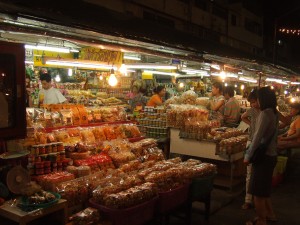
Care to take a break from all this power shopping? Well, there are local treats in a food stall nearby that seem to be very popular although I couldn’t identify most of them. Small restaurants can also be found at intervals along the perimeter. One even allows you to select your fresh fish from the tank.
If you would like to sit down and put your tired paws up, you can get a foot massage for less than $10 (U.S.) cash. Really. Right here and now. Fully clothed. In public.
It’s a bargain. I just can’t vouch for the quality of the massage. That would depend on the person providing it. And whether he/she understands and heeds your requests for lighter pressure. They do seem to be a little too enthusiastic. Some patrons seemed to purr with pleasure while others grimaced in quiet pain.
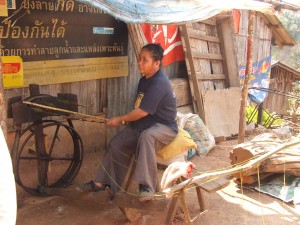 First, a member of this hill tribe took us on a short walking tour of the village. The inhabitants live as they have for generations in simple huts. Families still cultivate crops of staples such as corn, rice and soybeans.
First, a member of this hill tribe took us on a short walking tour of the village. The inhabitants live as they have for generations in simple huts. Families still cultivate crops of staples such as corn, rice and soybeans.
With the assistance of our guide as translator, we were able to speak with a local woman spinning thread outside hers. The thread would be used in the distinctive and intricate handmade Hmong weaving and embroidery they are known for. Of course, fine examples of this colorful work were available for purchase.
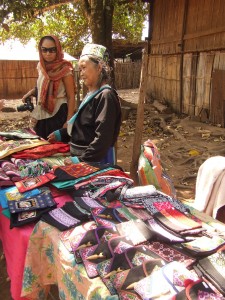 I was suddenly reminded of childhood fairy tales involving spinning wheels. A princess who pricked her finger while spinning wool into yarn, falling into a deep sleep for a hundred years. Apparently, it was just a hobby and no one was relying on her handiwork for their livelihood. A girl spinning straw into gold based on someone else’s greed until she could cleverly gain her release. Fabric is nowhere near as profitable as precious metals.
I was suddenly reminded of childhood fairy tales involving spinning wheels. A princess who pricked her finger while spinning wool into yarn, falling into a deep sleep for a hundred years. Apparently, it was just a hobby and no one was relying on her handiwork for their livelihood. A girl spinning straw into gold based on someone else’s greed until she could cleverly gain her release. Fabric is nowhere near as profitable as precious metals.
Today, machines have taken over textile manufacturing in uniform mass quantities. Garments produced by the thousands in factories are shipped all over the world. But here and now in Thailand, needlework is still done by women in a labor-intensive process with attention to detail.
Remember those young girls waiting. Patience is an important skill in this type of work. These crafts will be passed down to them from their mothers as they were from their grandmothers.
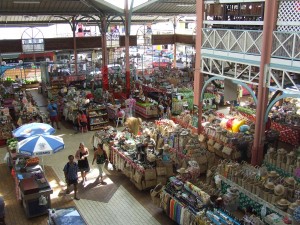
Le Marche
In the very heart of Papeete’s business district lies the public market that has occupied an entire city block for over 155 years. A block back from the waterfront, Le Marche is a 2-story open-air building containing hundreds of vendor stalls inside and around its outer perimeter. There you will find food as well as souvenir and gift items : fresh flowers, fruits, vegetables and fish in the produce sections; hand-made crafts such as woven hats & baskets, wood carvings and elaborate shell jewelery; brightly-colored pareos (sarongs) literally by the hundreds; lightly-scented, moisturizing monoi (coconut oil) products; and some intriguing tropical fruit jams, jellies and juices.
Remember that Papeete is the both the capital and the commercial center of Tahiti. This is one-stop shopping at its best. You will find the largest variety of local products at some of the best prices in the islands. But I go there just as much for the direct contact with local people.
The local currency is the French Pacific Franc (CFP or XPF). It is handy to have some spending money for small items such as drinks, snacks and postcards. U.S. dollars may be conveniently exchanged at the airport or hotels. Most larger businesses in tourist areas take major credit cards. However, Visa and Mastercard are more widely accepted than American Express. Be aware that smaller stores and street vendors may only deal in cash.
A quick word of advice – do not even attempt to barter with vendors. Bargaining and haggling over prices is NOT customary here. You may only manage to insult them. Always be friendly and polite when asking if they accept U.S. dollars and you may find that they have actually rounded the price down slightly. Just smile sweetly as you say Merci (french) or Mauruuru (tahitian) and walk away with your purchase(s).
The Night Bazaar in Chiang Mai is probably the most famous shoppertunity in Thailand, although the open air market is actually open for business both day and night in the downtown area. The sidewalk is lined in both directions with tiny stalls selling cheap Thai souvenirs and counterfeit designer goods.
 Bypass these for the real finds. Inside the main market square, vendors have tables set up in a grid offering everything from local foods to cotton clothing to handicrafts. According to everyone I spoke to in Bangkok and Chiang Mai, this is the BEST place to shop for locally-produced items.
Bypass these for the real finds. Inside the main market square, vendors have tables set up in a grid offering everything from local foods to cotton clothing to handicrafts. According to everyone I spoke to in Bangkok and Chiang Mai, this is the BEST place to shop for locally-produced items.
 You can outfit yourself in a new wardrobe with shirts, skirts, a shoulder bag or backpack, sandals, a watch and jewelry. Redecorate your home with hand-carved wood furniture, glossy black lacquerware or pale green Celadon potter. Toss in some matching pillowcases and quilts with some strings of colorful miniature paper lanterns.
You can outfit yourself in a new wardrobe with shirts, skirts, a shoulder bag or backpack, sandals, a watch and jewelry. Redecorate your home with hand-carved wood furniture, glossy black lacquerware or pale green Celadon potter. Toss in some matching pillowcases and quilts with some strings of colorful miniature paper lanterns.
I was intrigued by some iconic images of Thailand, available for sale, ready to frame and display. Unfortunately, I was unable to find the owner of the booth to inquire about the photographer. And I even noticed a few individuals dressed in hill tribe garb selling the type of richly textured hand-loomed fabrics and embroidery we had just seen in the upcountry village.

Care to take a break from all this power shopping? Well, there are local treats in a food stall nearby that seem to be very popular although I couldn’t identify most of them. Small restaurants can also be found at intervals along the perimeter. One even allows you to select your fresh fish from the tank.
If you would like to sit down and put your tired paws up, you can get a foot massage for less than $10 (U.S.) cash. Really. Right here and now. Fully clothed. In public.
It’s a bargain. I just can’t vouch for the quality of the massage. That would depend on the person providing it. And whether he/she understands and heeds your requests for lighter pressure. They do seem to be a little too enthusiastic. Some patrons seemed to purr with pleasure while others grimaced in quiet pain.
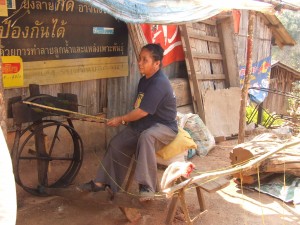 First, a member of this hill tribe took us on a short walking tour of the village. The inhabitants live as they have for generations in simple huts. Families still cultivate crops of staples such as corn, rice and soybeans.
First, a member of this hill tribe took us on a short walking tour of the village. The inhabitants live as they have for generations in simple huts. Families still cultivate crops of staples such as corn, rice and soybeans.
With the assistance of our guide as translator, we were able to speak with a local woman spinning thread outside hers. The thread would be used in the distinctive and intricate handmade Hmong weaving and embroidery they are known for. Of course, fine examples of this colorful work were available for purchase.
 I was suddenly reminded of childhood fairy tales involving spinning wheels. A princess who pricked her finger while spinning wool into yarn, falling into a deep sleep for a hundred years. Apparently, it was just a hobby and no one was relying on her handiwork for their livelihood. A girl spinning straw into gold based on someone else’s greed until she could cleverly gain her release. Fabric is nowhere near as profitable as precious metals.
I was suddenly reminded of childhood fairy tales involving spinning wheels. A princess who pricked her finger while spinning wool into yarn, falling into a deep sleep for a hundred years. Apparently, it was just a hobby and no one was relying on her handiwork for their livelihood. A girl spinning straw into gold based on someone else’s greed until she could cleverly gain her release. Fabric is nowhere near as profitable as precious metals.
Today, machines have taken over textile manufacturing in uniform mass quantities. Garments produced by the thousands in factories are shipped all over the world. But here and now in Thailand, needlework is still done by women in a labor-intensive process with attention to detail.
Remember those young girls waiting. Patience is an important skill in this type of work. These crafts will be passed down to them from their mothers as they were from their grandmothers.
Another time-saving flight and we are landing at the Wilson airstrip in the Maasai Mara Game Reserve to the southwest.
The Maasai Mara offers the greatest concentration and diversity of wildlife in Kenya. But first, let’s sidetrack for a cultural safari. The local Maasai are a handsome people – tall, slender and elegant. They are known for their distinctive woven red fabrics and elaborate beaded jewelry. Their beautiful ebony skin and brightly colored attire contrast sharply with the dusky earth tones of the surrounding savannah.
It is possible to visit a Maasai village or manyatta with a guide contingent on the permission of the chief. The settlement is comprised of a circle of rounded huts made from a framework of sticks packed with dung. These are low structures with several small unadorned rooms inside for family members and perhaps a small calf.
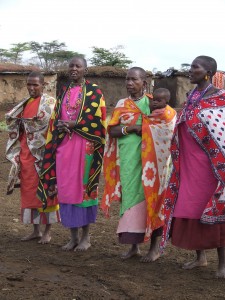 Women from the tribe welcome visitors with song. Next, young men demonstrate their strength and agility with a jumping ritual. The Maasai are traditionally herdsmen with cattle being their source of food, status and wealth. The cattle are brought into the center at night to protect them from predators.
Women from the tribe welcome visitors with song. Next, young men demonstrate their strength and agility with a jumping ritual. The Maasai are traditionally herdsmen with cattle being their source of food, status and wealth. The cattle are brought into the center at night to protect them from predators.
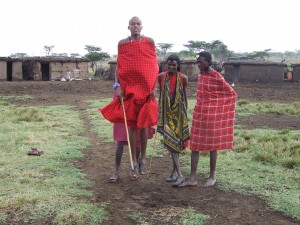
Outside the compound, another circle has been set up with a huge assortment of handicrafts displayed on hand woven cloths: intricately beaded bracelets and necklaces, hand woven siskal baskets, wood carvings of indigenous animals.
I hope you brought some cash with you today. Remember the economy here operates on cash, not credit. Greenbacks are most welcome as are European currencies. But be sure to inquire about the prices before you scoop up an armful of souvenirs and gifts. I witnessed one traveler make this mistake. She had a severe case of sticker shock when the total came to over $200 U.S.! That’s two hundred, not twenty. These were very expensive trinkets. An interesting negotiation ensued.
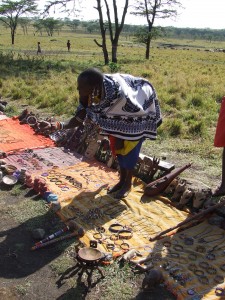
My impression is that this particular village has become accustomed to a steady stream of foreigners. One of the chief’s sons gave us a rather cursory tour and answered our questions but quickly led us to the shopping opportunity. I know that cash flow has far reaching benefits for local residents in these areas. However, this village seemed a little jaded from perhaps too much superficial contact.
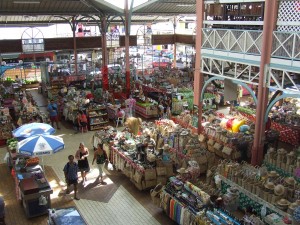 In the very heart of Papeete’s business district lies the public market that has occupied an entire city block for over 155 years. A block back from the waterfront, Le Marche is a 2-story open-air building containing hundreds of vendor stalls inside and around its outer perimeter. There you will find food as well as souvenir and gift items : fresh flowers, fruits, vegetables and fish in the produce sections; hand-made crafts such as woven hats & baskets, wood carvings and elaborate shell jewelery; brightly-colored pareos (sarongs) literally by the hundreds; lightly-scented, moisturizing monoi (coconut oil) products; and some intriguing tropical fruit jams, jellies and juices.
In the very heart of Papeete’s business district lies the public market that has occupied an entire city block for over 155 years. A block back from the waterfront, Le Marche is a 2-story open-air building containing hundreds of vendor stalls inside and around its outer perimeter. There you will find food as well as souvenir and gift items : fresh flowers, fruits, vegetables and fish in the produce sections; hand-made crafts such as woven hats & baskets, wood carvings and elaborate shell jewelery; brightly-colored pareos (sarongs) literally by the hundreds; lightly-scented, moisturizing monoi (coconut oil) products; and some intriguing tropical fruit jams, jellies and juices.
Remember that Papeete is the both the capital and the commercial center of Tahiti. This is one-stop shopping at its best. You will find the largest variety of local products at some of the best prices in the islands. But I go there just as much for the direct contact with local people.
The local currency is the French Pacific Franc (CFP or XPF). It is handy to have some spending money for small items such as drinks, snacks and postcards. U.S. dollars may be conveniently exchanged at the airport or hotels. Most larger businesses in tourist areas take major credit cards. However, Visa and Mastercard are more widely accepted than American Express. Be aware that smaller stores and street vendors may only deal in cash.
A quick word of advice – do not even attempt to barter with vendors. Bargaining and haggling over prices is NOT customary here. You may only manage to insult them. Always be friendly and polite when asking if they accept U.S. dollars and you may find that they have actually rounded the price down slightly. Just smile sweetly as you say Merci (french) or Mauruuru (tahitian) and walk away with your purchase(s).
 Bypass these for the real finds. Inside the main market square, vendors have tables set up in a grid offering everything from local foods to cotton clothing to handicrafts. According to everyone I spoke to in Bangkok and Chiang Mai, this is the BEST place to shop for locally-produced items.
Bypass these for the real finds. Inside the main market square, vendors have tables set up in a grid offering everything from local foods to cotton clothing to handicrafts. According to everyone I spoke to in Bangkok and Chiang Mai, this is the BEST place to shop for locally-produced items. You can outfit yourself in a new wardrobe with shirts, skirts, a shoulder bag or backpack, sandals, a watch and jewelry. Redecorate your home with hand-carved wood furniture, glossy black lacquerware or pale green Celadon potter. Toss in some matching pillowcases and quilts with some strings of colorful miniature paper lanterns.
You can outfit yourself in a new wardrobe with shirts, skirts, a shoulder bag or backpack, sandals, a watch and jewelry. Redecorate your home with hand-carved wood furniture, glossy black lacquerware or pale green Celadon potter. Toss in some matching pillowcases and quilts with some strings of colorful miniature paper lanterns.








 In the very heart of Papeete’s business district lies the public market that has occupied an entire city block for over 155 years. A block back from the waterfront, Le Marche is a 2-story open-air building containing hundreds of vendor stalls inside and around its outer perimeter. There you will find food as well as souvenir and gift items : fresh flowers, fruits, vegetables and fish in the produce sections; hand-made crafts such as woven hats & baskets, wood carvings and elaborate shell jewelery; brightly-colored pareos (sarongs) literally by the hundreds; lightly-scented, moisturizing monoi (coconut oil) products; and some intriguing tropical fruit jams, jellies and juices.
In the very heart of Papeete’s business district lies the public market that has occupied an entire city block for over 155 years. A block back from the waterfront, Le Marche is a 2-story open-air building containing hundreds of vendor stalls inside and around its outer perimeter. There you will find food as well as souvenir and gift items : fresh flowers, fruits, vegetables and fish in the produce sections; hand-made crafts such as woven hats & baskets, wood carvings and elaborate shell jewelery; brightly-colored pareos (sarongs) literally by the hundreds; lightly-scented, moisturizing monoi (coconut oil) products; and some intriguing tropical fruit jams, jellies and juices.